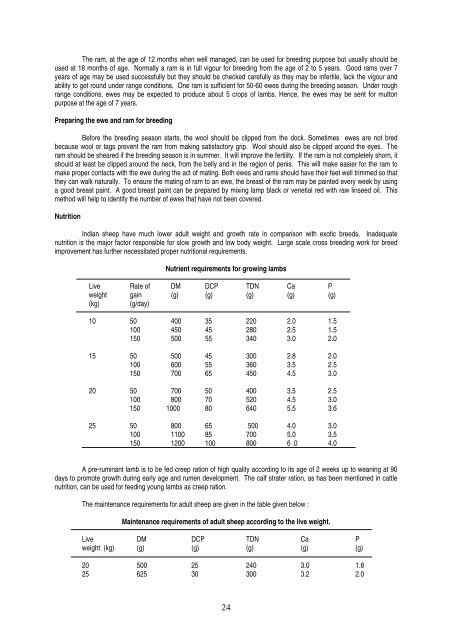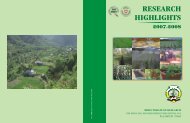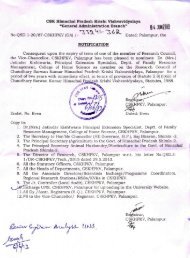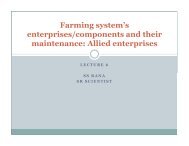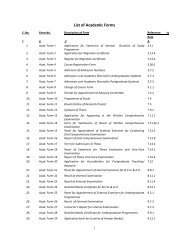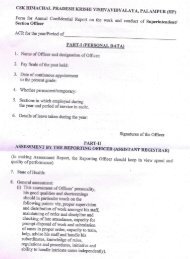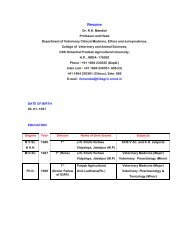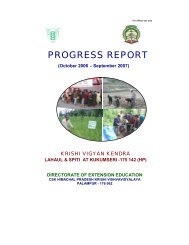animal production - CSK Himachal Pradesh Agricultural University ...
animal production - CSK Himachal Pradesh Agricultural University ...
animal production - CSK Himachal Pradesh Agricultural University ...
You also want an ePaper? Increase the reach of your titles
YUMPU automatically turns print PDFs into web optimized ePapers that Google loves.
The ram, at the age of 12 months when well managed, can be used for breeding purpose but usually should be<br />
used at 18 months of age. Normally a ram is in full vigour for breeding from the age of 2 to 5 years. Good rams over 7<br />
years of age may be used successfully but they should be checked carefully as they may be infertile, lack the vigour and<br />
ability to get round under range conditions. One ram is sufficient for 50-60 ewes during the breeding season. Under rough<br />
range conditions, ewes may be expected to produce about 5 crops of lambs. Hence, the ewes may be sent for mutton<br />
purpose at the age of 7 years.<br />
Preparing the ewe and ram for breeding<br />
Before the breeding season starts, the wool should be clipped from the dock. Sometimes ewes are not bred<br />
because wool or tags prevent the ram from making satisfactory grip. Wool should also be clipped around the eyes. The<br />
ram should be sheared if the breeding season is in summer. It will improve the fertility. If the ram is not completely shorn, it<br />
should at least be clipped around the neck, from the belly and in the region of penis. This will make easier for the ram to<br />
make proper contacts with the ewe during the act of mating. Both ewes and rams should have their feet well trimmed so that<br />
they can walk naturally. To ensure the mating of ram to an ewe, the breast of the ram may be painted every week by using<br />
a good breast paint. A good breast paint can be prepared by mixing lamp black or venetial red with raw linseed oil. This<br />
method will help to identify the number of ewes that have not been covered.<br />
Nutrition<br />
Indian sheep have much lower adult weight and growth rate in comparison with exotic breeds. Inadequate<br />
nutrition is the major factor responsible for slow growth and low body weight. Large scale cross breeding work for breed<br />
improvement has further necessitated proper nutritional requirements.<br />
Nutrient requirements for growing lambs<br />
Live Rate of DM DCP TDN Ca P<br />
weight gain (g) (g) (g) (g) (g)<br />
(kg) (g/day)<br />
10 50 400 35 220 2.0 1.5<br />
100 450 45 280 2.5 1.5<br />
150 500 55 340 3.0 2.0<br />
15 50 500 45 300 2.8 2.0<br />
100 600 55 360 3.5 2.5<br />
150 700 65 450 4.5 3.0<br />
20 50 700 50 400 3.5 2.5<br />
100 800 70 520 4.5 3.0<br />
150 1000 80 640 5.5 3.6<br />
25 50 800 65 500 4.0 3.0<br />
100 1100 85 700 5.0 3.5<br />
150 1200 100 800 6 .0 4.0<br />
A pre-ruminant lamb is to be fed creep ration of high quality according to its age of 2 weeks up to weaning at 90<br />
days to promote growth during early age and rumen development. The calf strater ration, as has been mentioned in cattle<br />
nutrition, can be used for feeding young lambs as creep ration.<br />
The maintenance requirements for adult sheep are given in the table given below :<br />
Maintenance requirements of adult sheep according to the live weight.<br />
Live DM DCP TDN Ca P<br />
weight (kg) (g) (g) (g) (g) (g)<br />
20 500 25 240 3.0 1.8<br />
25 625 30 300 3.2 2.0<br />
24


